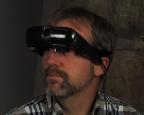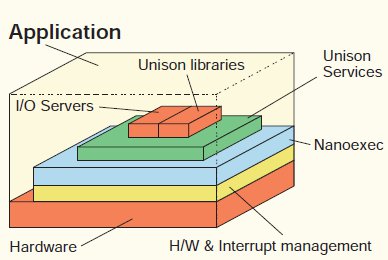Low-vision eyewear runs Linux-compatible Unison 5.2 RTOS
Sep 19, 2011 — by Eric Brown — from the LinuxDevices Archive — 36 viewsRoweBots announced that its minimalist, Linux- and POSIX-compatible “Unison” real-time operating system (RTOS) powers eSight's Alivios Intelligent Eyewear. Currently in clinical trials, Alivios helps to improve vision in people with eye diseases such as macular degeneration, combining Unison OS 5.2, a Texas Instruments (TI) DaVinci processor, an HD video camera, and “near-to-eye” displays, says the company.
RoweBots' Unison OS "hard" real-time operating system (RTOS) is compatible with Linux and POSIX, enabling easier application development and porting, says Waterloo, Canada-based RoweBots. Unison OS first came to our attention in August 2010 when Actel Corp. announced that its SmartFusion FPGAs (field programmable gate arrays) could run the OS directly in as little as 1KB of RAM.
 Neither RoweBots or eSight offer many hardware details on the new eSight Alivios Intelligent Eyewear (pictured at right). RoweBots, however, used the product win to reveal new features in its newly launched Unison OS 5.2, (see farther below).
Neither RoweBots or eSight offer many hardware details on the new eSight Alivios Intelligent Eyewear (pictured at right). RoweBots, however, used the product win to reveal new features in its newly launched Unison OS 5.2, (see farther below).
This month, eSight is launching Alivios in 10 clinical trials in low-vision rehabilitation clinics in the U.S. and Canada. The trials will involve 20,000 patients, according to a BioTuesdays story on the launch, which is linked to from the stealth-mode eSight website.
The Alivios Intelligent Eyewear, which appears somewhat like a cross between a pair of sunglasses and VR-gaming headgear, is expected to be available commercially in selected clinics by the end of the year for about $6,000, says RoweBots. The eyewear combines "breakthrough advances in digital video capture and display with proprietary image processing algorithms to help people challenged with low vision," says the company.

Alivios Intelligent Eyewear diagram
Source: BioTuesdays
eSight posted a YouTube video testimonial from Justice William Wolski, an Ontario Provincial Court judge, regarding the device's laudatory effects on his low-vision Stargardt's condition. These include the ability to better recognize faces and view facial expressions, as well as enjoy rich colors, said Wolski (pictured below).

Ontario Provincial Judge William Wolski in YouTube testimonial with Alivios device
Source: eSight
Alivios is best suited for age-related eye problems in which loss of acuity and contrast are the chief obstacles, according to BioTuesdays. Suitable conditions are said to include macular degeneration (AMD), diabetic retinopathy, glaucoma, Stargardt's disease, and Leber's disease.
In early testing, 60 percent of patients have seen a dramatic benefit, according to CEO Kevin Rankin, who is interviewed in the story. "We sort of punch through the fog and present an enhanced image to the back of the eye," Rankin was quoted as saying. "It's personalized and programmed for each individual situation."
The Alivios eyewear incorporates a low-vision patient's prescription lenses, and then enhances them with features including a built-in miniature HD video camera and image processing software, says BioTuesdays. The eyewear is said to be connected to a belt-worn computer "about twice the size of a Blackberry."
Current low-vision assistance technologies include expensive, non-portable desktop readers, as well as magnifiers, "which are easy to use and inexpensive, but don't enhance images," says the story.
According to RoweBots, the device runs Unison OS 5.2 on an unnamed, HD-ready Texas Instruments (TI) DaVinci processor. Judging from the testimonial quote below, the processor is likely the Linux-ready DaVinci DM37xx, which is featured in the latest BeagleBoard-xM development board. The DM3730 uses a 1GHz Cortex-A8 core, a 800MHz C64x+ DSP core, and a 3D graphics accelerator, while the DaVinci DM3725 model is similar except for the 3D support. The processors support 720p video capture.
Unison 5.2
According to RoweBots, the Alivios device would not be possible if not for its latest 5.2 release of the Unision OS. This "ultra-tiny embedded Linux-compatible RTOS opens a broad set of medical, embedded or imaging applications to Linux- and POSIX-compatible development," according to the company.
(The POSIX standard describes a set of functions for thread creation and management called POSIX threads, or pthreads, which are commonly used in real-time applications.)
Unison 5.2 offers 32 bit architectural support for system on chip (SoC) MCUs, digital signal controllers (DSCs), and digital signal processors (DSPs), says RoweBots. Features are said to include an "extensive" I/O and add-on module library, as well as a modular architecture said to be scalable from "very tiny to MByte applications."

Unison OS architecture
- USB host and device I/O
- extensive wireless I/O
- 6loWPAN
- 802.15.4 SimpliciTI
- Bluetooth
- enhanced networking
- TCP IPv6 with IPv4
- SNMP v1, 2c, 3
- NAND flash file system
- graphics
- remedy tools
- RED analyzer
- bootloader
Over 50 Unison demonstration programs are said to run on ARM and ARM/DSP DaVinci digital media processor development kits. The apps are said to work out of the box in less than 10 minutes.
Unison supports a wide variety of ARM chips ranging from Cortex-M3 to Cortex-A8 processors, as well as Microchip, Renesas, Freescale Coldfire, and ADI Blackfin and SHARC platforms. Unison also supports a variety of TI DSPs and Altera and Xilinx FPGAs, says the company.
Memory footprint ranges from 1.2K of RAM and 6K of flash to 1MB of RAM and flash memory apiece, says RoweBots. One of the chief appeals to eSight, however, may have been Unison's "zero-boot" capability, which is said to measure in microseconds. By comparison, the fastest full-Linux distros struggle to boot in less than 10 seconds, according to the company.
Like any good RTOS, Unison offers hard real-time performance with deterministic responses and minimal latency. The Linux kernel is increasingly approaching hard real-time capabilities with the latest PREEMPT_RT patch series, but may never match the low latency and dependability of RTOSes, which are used in various mission-critical applications. In the case of Alivios, eyesight is the mission critical application.
RoweBots' explanation of Unison's Linux compatibility is somewhat vague. By not using the Linux kernel itself, Unison can boot faster and offer better real-time performance, says the company. In addition, RoweBots is not forced to use GPL licensing, which RoweBots sees as a positive for most of its customers.
Unison is a dual-licensed platform, with both open source and proprietary, commercial versions available. The exact license type of the open source version dos not appear to be listed, but it's said to be free for all components except the TCP networking module.
The commercial version offers better documentation, extended features, a large set of add on modules, as well as commercial support, training and customization, says RoweBots. The key advantage, however, is that the commercial version provides the latest version of Unison, whereas it appears that the open source version may only be available for Unison 4.x. Judging from the major feature introduced in version 5.2, the earlier version may be fairly primitive.
RoweBots also offers a similar DSPnano OS that is said to be fully Linux and POSIX compatible. DSPnano offers 8- and 16-bit architectural support for SoC MCUs, DSCs, and DSPs, while Unison focuses on 32-bit processors.
Stated Juan Gonzales, DM37x DaVinci Product Marketing Manager at TI, "The ability to replace Linux with Unison to reduce complexity, improve performance and achieve a near-zero boot time will eliminate very costly optimization and device driver redesign for many designs."
Stated Kevin Rankin, CEO of eSight, "Unison provided us with improved performance and real-time response from boot, to USB image transfer, focusing, image acquisition and display. These features will dramatically improve the Alivios customer experience. Furthermore, our software development and maintenance costs will be significantly better than they were with a generic embedded Linux architecture."
Availability
The Alivios Intelligent Eyewear system is entering trials in Sept. 2011 in the U.S. and Canada and is expected to be available commercially in selected eye clinics by the end of the year for about $6,000. More information may be found at the eSight website.
Unison OS 5.2 is available now in its commercial version, but it does not appear that the open source version is currently available with version 5.2. More information may be found at the RoweBots website.
This article was originally published on LinuxDevices.com and has been donated to the open source community by QuinStreet Inc. Please visit LinuxToday.com for up-to-date news and articles about Linux and open source.